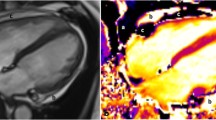Abstract
To describe findings of patients with surgically confirmed pericardial disease on state of the art MR sequences. Retrospective review was performed for patients who underwent pericardiectomy and preoperative MR over a 5 year period ending in 2009. Patients’ records were reviewed to confirm the diagnosis of chronic recurrent pericarditis, constrictive pericarditis, or pericardial tumor. MR imaging findings of pericardial thickness, IVC diameter, presence or absence of pericardial or pleural effusion, pericardial edema, pericardial enhancement, and septal “bounce” were recorded. Patients with constriction had a larger IVC diameter (3.1 ± 0.4 cm) than patients with recurrent pain and no constriction (2.0 ± 0.4 cm). Mean pericardial thickness for the 16 patients with chronic recurrent pericarditis but no evidence of constriction was 4.8 ± 2.9 mm. Mean pericardial thickness for patients with constriction was 9.2 ± 7.0 cm with calcification, and 4.6 ± 2.1 cm without calcification. 94% of patients with chronic recurrent pericarditis had gadolinium enhancement of the pericardium, while 76% of patients with constriction had pericardial enhancement. Septal “bounce” was present in 19% of chronic recurrent pericarditis cases and 86% of constriction cases. 5 patients had a pericardial neoplasm, 1 of which was not identified preoperatively. State of the art MR techniques can identify significant and distinct findings in patients with chronic recurrent pericarditis, constrictive pericarditis, and pericardial tumors.








Similar content being viewed by others
References
Stark DD, Higgins CB, Lanzer P et al (1984) Magnetic resonance imaging of the pericardium: normal and pathologic findings. Radiology 150:469–474
Taylor AM, Dymarkowski S, Verbeken EK (2006) Detection of pericardial inflammation with late-enhancement cardiac magnetic resonance imaging: initial results. Eur Radiol 16:569–574
Sechtem U, Tscholakoff D, Higgins CB (1986) MRI of the normal pericardium. AJR 147:239–244
Sechtem U, Tscholakoff D, Higgins CB (1986) MRI of the abnormal pericardium. AJR 147:245–252
Taylor AM, Dymarkowski S, Verbeken EK, Bogaert J (2006) Detection of pericardial inflammation with late-enhancement cardiac magnetic resonance imaging: initial results. Eur Radiol 16:569–574
Masui T, Finck S, Higgins CB (1992) Constrictive pericarditis and restrictive cardiomyopathy: evaluation with MR imaging. Radiology 182:369–373
Klein C, Graf K, Fleck E, Nagel E (2003) Acute fibrinous pericarditis assessed with magnetic resonance imaging. Circulation 107:e82
Watanabe A, Hara Y, Hamada M et al (1998) A case of effusive-constrictive pericarditis: an efficacy of Gd-DTPA enhanced magnetic resonance imaging to detect a pericardial thickening. Magn Resonan Imaging 16:347–350
Matsuoka H, Hamada M, Honda T et al (1994) Evaluation of acute myocarditis and pericarditis by Gd-DTPA enhanced magnetic resonance imaging. Eur Heart J 15:283–284
Sa MI, Kiesewetter CH, Jagathesan R, Prasad SK (2009) Acute pericarditis assessed with magnetic resonance imaging: a new approach. Circulation 119:3183–3186
Giorgi B, Mollet NRA, Dymarkoswki S, Rademakers FA, Bogaert J (2003) Assessment of ventricular septal motion in patients clinically suspected of constrictive pericarditis, using magnetic resonance imaging. Radiology 228:417–424
Oh KY, Shimizu M, Edwards WD, Tazelaar HD, Danielson GK (2001) Surgical pathology of the parietal pericardium: a study of 344 cases (1993–1999). Cardiovasc Pathol 10(4):157–168
Talreja DR, Edwards WD, Danielson GK, Schaff HV, Tajik AJ, Tazelaar HD, Breen JF, Oh JK (2003) Constrictive pericarditis in 26 patients with histologically normal pericardial thickness. Circulation 108(15):1852–1857
Mueller C, Globits S, Glogar D, Klepetko W, Knoflach P (1991) Constrictive pericarditis without significant hemodynamic changes as a cause of oedema formation due to protein-losing enteropathy. Eur Heart J 12:1140–1143
Nishimura RA (2001) Constrictive pericarditis in the modern era: a diagnostic dilemma. Heart 86:619–623
Conflict of interest
None.
Author information
Authors and Affiliations
Corresponding author
Rights and permissions
About this article
Cite this article
Young, P.M., Glockner, J.F., Williamson, E.E. et al. MR imaging findings in 76 consecutive surgically proven cases of pericardial disease with CT and pathologic correlation. Int J Cardiovasc Imaging 28, 1099–1109 (2012). https://doi.org/10.1007/s10554-011-9916-0
Received:
Accepted:
Published:
Issue Date:
DOI: https://doi.org/10.1007/s10554-011-9916-0




